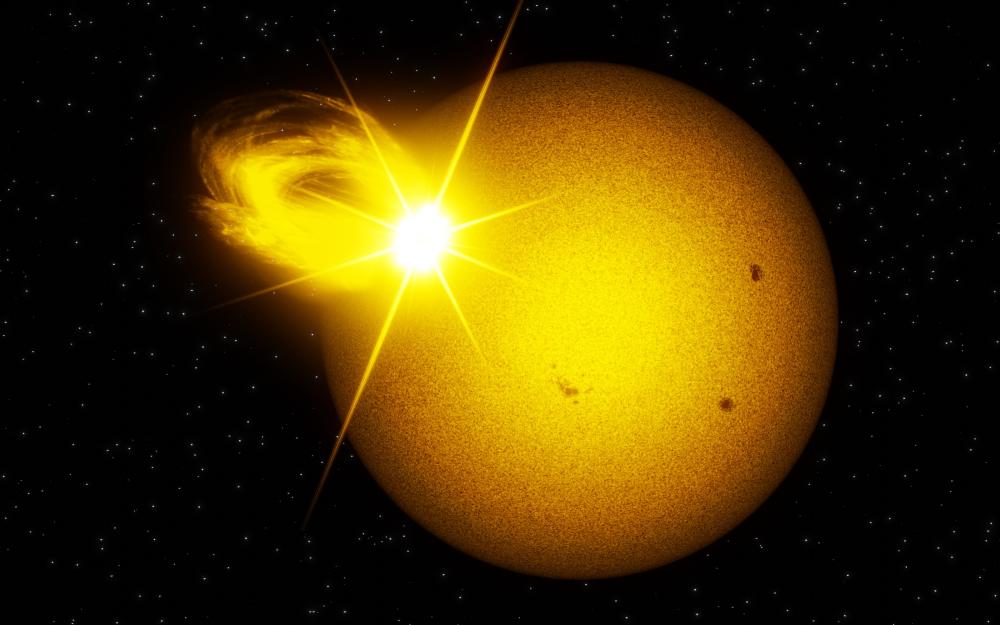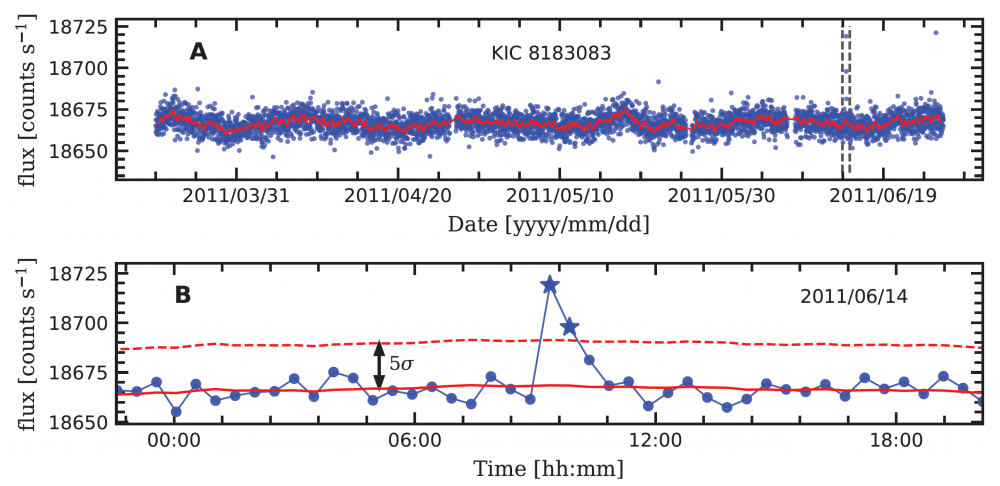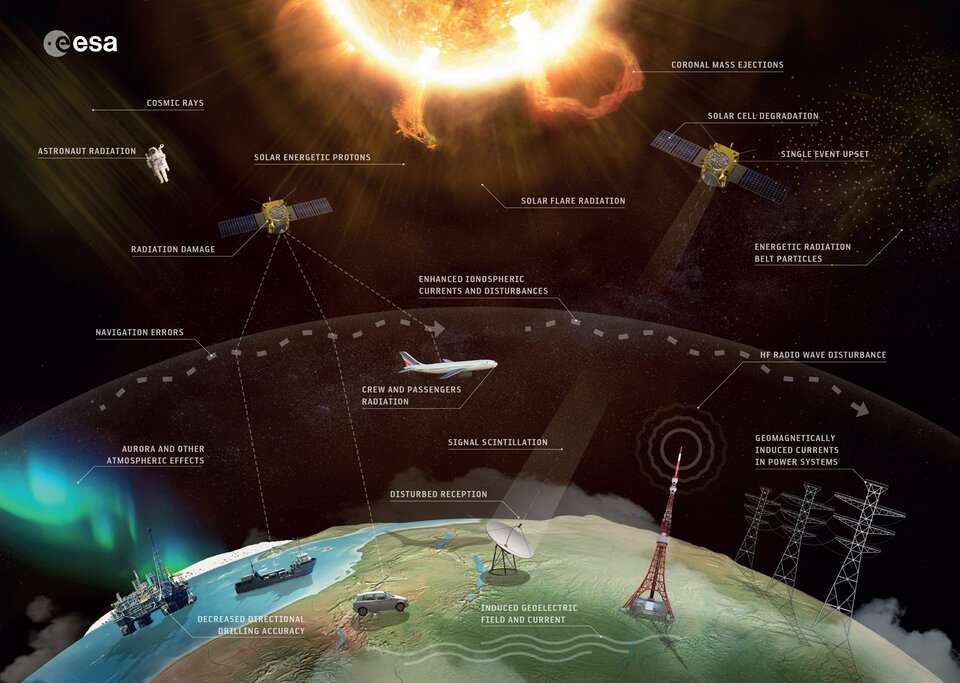Follow us on Google News (click on ☆)

Figure 1 - Artist's illustration of a superflare produced by the Sun.
Credit: Max-Planck-Institut
To determine if the Sun is capable of producing such monsters, an international team, including the Astrophysics Department of IRFU at CEA Paris-Saclay, analyzed tens of thousands of stars similar to the Sun. The researchers discovered that not only can the Sun generate superflares, but they would occur on average once per century, a frequency much higher than previously estimated.
However, traces left by ancient solar flares in terrestrial archives show that these superflares are not always accompanied by massive ejections of matter, a chance for our technology-dependent society vulnerable to these events. To better understand and anticipate these solar outbursts, researchers rely on complex numerical simulations to study the mechanisms behind solar magnetism and flares.
Could the Sun generate superflares?
Flares are sudden, localized, and highly intense electromagnetic emissions from stars like the Sun. These phenomena release a considerable amount of energy in a very short time (see figure 1). They are frequently accompanied by massive plasma ejections, called coronal mass ejections (CMEs).
When the solar energetic particles (SEPs) from these eruptions reach Earth, they pose a significant radiation hazard to satellites, aircraft, and humans. The powerful solar storms observed this year, which generated auroras even in low-latitude regions, testify to the Sun's impetuous nature. But could it produce even more intense eruptions, superflares, whose damage on Earth would be catastrophic? And if so, how often could they occur?

Figure 2 - Example of a superflare observed in the light curve (blue dots) of a star from the studied sample.
The star KIC 8183083, similar to the Sun, exhibits a strong variation in brightness, characteristic of a superflare, delimited here by vertical dashed lines (top panel). When zooming in on it (see bottom panel), two measurements of the luminous flux, symbolized by a star shape, significantly exceed (greater than 5σ) the other values.
Credit: Vasilyev et al. 2024
Evidence of the worst solar "outbursts" can be found in the rings of prehistoric trees and millennial ice cores. Analysis of these terrestrial archives, covering the last 12,000 years, suggests that an extreme solar storm occurs on average every 1,500 years. However, this estimate might be underestimated, as the relationship between superflares and extreme solar particle ejections remains uncertain. As for direct measurements of solar radiation, they only date back to the space age, a period too short to provide definitive conclusions.
An alternative is to statistically study superflares on stars similar to the Sun. If the properties of these stars sufficiently match those of our star, the frequency of observed superflares can offer an indirect but valuable estimate of the frequency of solar superflares.
Surprisingly frequent superflares
For this study, researchers used data from the Kepler telescope (NASA), which continuously observed the brightness variations of thousands of stars for 4 years, from 2009 to 2013. They then selected stars whose temperature and luminosity are comparable to those of the Sun, with precise locations determined thanks to the Gaia satellite. The sample thus constituted includes 56,450 stars, representing the equivalent of 220,000 years of stellar activity, about 18 times more than terrestrial archives.
Superflares, which release more than an octillion joules in a few moments, manifest as pronounced peaks in the stars' light curves (see figure 2). After eliminating potential biases, such as cosmic radiation or nearby asteroids, researchers identified 2,889 superflares on 2,527 stars, averaging one superflare per star every 100 years. Even by restricting the sample to only stars with characteristics closest to those of the Sun, the same eruption frequency is found.
"We were very surprised by the frequency of these superflares," said Dr. Valeriy Vasilyev, lead author of the study and researcher at the Max Planck Institute.
Indeed, previous studies have reported frequencies about two orders of magnitude lower than those observed in this study, between 1,000 to 10,000 years. However, these estimates are incompatible with observed solar flares, likely due to biases in the analyses, related to uncertain identification of eruption sources.
Superflares dictated by a power law
From the energy distribution of the number of stellar eruptions per year and per unit of energy (see Figure 3), researchers observed that the frequency of eruptions decreases with the energy released according to a power law of type E-α, where the exponent α determines the speed of this decrease. The value of α for the Sun, obtained from measurements made in space between 1986 and 2020, is in very good agreement with stellar measurements, thus validating the estimates of superflare frequency (E>1034 erg) at about one per century.
However, the question arises: can the Sun, with its slow rotation (28 days), accumulate enough energy to generate such eruptions? In addition to their contribution to the interpretation and analysis of data, dynamo simulations conducted by researchers from the Astrophysics Department of CEA have shown that such a phenomenon is energetically possible.
"High-performance dynamo calculations of solar-type stars easily explain the magnetic origins of the intense energy release during these superflares." Dr. Allan-Sacha Brun

Figure 3 - Cumulative distributions of the annual frequency of solar and stellar eruptions as a function of their energy (in erg).
A superflare is defined as an eruption whose energy E exceeds 1034 erg (symbolized by a lightning bolt). The extrapolation of solar observations (green dashed line), obtained from space between 1986 and 2020 (green histogram), suggests an average occurrence of one solar superflare per century (10-2/year). Measurements of stellar eruptions on a vast sample of stars, similar to the Sun, observed by the Kepler telescope (blue histograms for the complete sample, orange for a restricted sample), confirm this frequency of superflares (black dashed line). In contrast, estimates based on terrestrial archives (green squares), such as tree rings and ice cores, indicate an occurrence about 10 to 100 times less frequent. This difference is explained by the fact that superflares are not systematically accompanied by massive ejections of energetic and charged particles.
Credit: Vasilyev et al. 2024.
How to protect against dangerous space storms
This study reveals that the Sun could generate superflares at a higher frequency than previously estimated: about once per century. These phenomena can release energies up to 100 times greater than those of the most powerful solar flare ever recorded, which occurred on October 28, 2003. Fortunately, terrestrial archives show that these superflares are not systematically accompanied by massive ejections of charged and energetic particles, which is a chance for our technology-dependent civilization.
Indeed, such ejections could lead to catastrophic consequences (see figure 4), causing, for example, the loss of satellites, power grid outages, deviation or even stoppage of flights, radio blackouts, etc.

Figure 4 - Consequences on Earth of disturbances related to solar activity in the fields of space (astronauts, satellites), communications (geolocation, radio), aeronautics (radiation), and ground electrical installations.
Credit: ESA
This study therefore highlights the importance of better understanding our Sun to anticipate these extreme events and limit their effects. But this task is far from easy. Real-time monitoring of solar flares only allows for a limited reaction, as dangerous particles and radiation reach Earth in just 8 minutes, a time too short to implement effective countermeasures.
It is therefore essential to develop means to anticipate the future states of the Sun. For this, CEA researchers use complex numerical simulations and assimilate real data into these models capable of reproducing these phenomena, a discipline known as space weather. It aims to study the effects of solar flares on Earth and develop strategies to protect against them.
The Astrophysics Department of IRFU at CEA Paris-Saclay has made this its specialty. Using supercomputers, researchers numerically simulate the Sun and the complex medium between the Sun and Earth, where the solar wind and magnetosphere interact together (e.g., projects Whole Sun, Stormgenesis, and WindTRUST).
This work relies on a vast network of continuous observations of the Sun, notably thanks to the STIX instrument, partly designed at CEA Paris-Saclay and onboard the Solar Orbiter satellite. This instrument provides valuable X-ray spectro-imaging data to study the physical processes behind solar flares.
From 2031, researchers will also be able to rely on the Vigil probe from ESA (notably the JEDI instrument for which CEA is a scientific co-I), which, from an observation post on the side of the Sun, will monitor in near real-time the precursors of dangerous phenomena before they are visible from Earth. Finally, from late 2026, the Plato satellite (ESA), a worthy successor to Kepler, for which CEA has a hardware and scientific contribution, will strengthen the study of the Sun by enabling statistical comparisons with similar stars.
The study was published on December 13, 2024, in the journal Science.